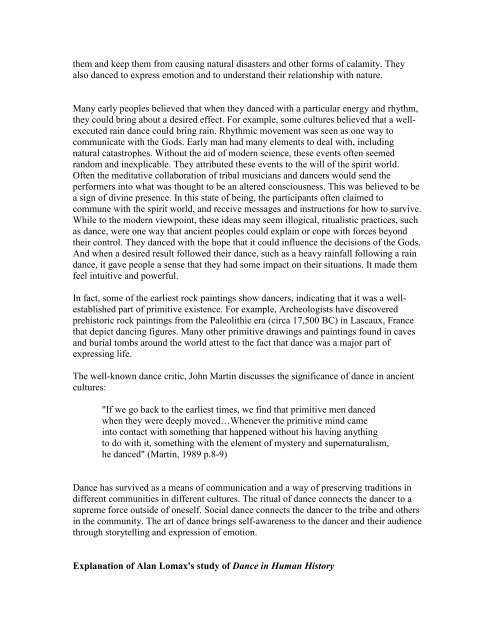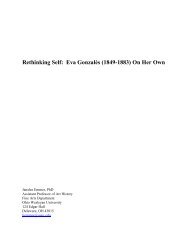2012 HUIC - Hawaii University International Conference on Arts and ...
2012 HUIC - Hawaii University International Conference on Arts and ...
2012 HUIC - Hawaii University International Conference on Arts and ...
Create successful ePaper yourself
Turn your PDF publications into a flip-book with our unique Google optimized e-Paper software.
them <strong>and</strong> keep them from causing natural disasters <strong>and</strong> other forms of calamity. They<br />
also danced to express emoti<strong>on</strong> <strong>and</strong> to underst<strong>and</strong> their relati<strong>on</strong>ship with nature.<br />
Many early peoples believed that when they danced with a particular energy <strong>and</strong> rhythm,<br />
they could bring about a desired effect. For example, some cultures believed that a wellexecuted<br />
rain dance could bring rain. Rhythmic movement was seen as <strong>on</strong>e way to<br />
communicate with the Gods. Early man had many elements to deal with, including<br />
natural catastrophes. Without the aid of modern science, these events often seemed<br />
r<strong>and</strong>om <strong>and</strong> inexplicable. They attributed these events to the will of the spirit world.<br />
Often the meditative collaborati<strong>on</strong> of tribal musicians <strong>and</strong> dancers would send the<br />
performers into what was thought to be an altered c<strong>on</strong>sciousness. This was believed to be<br />
a sign of divine presence. In this state of being, the participants often claimed to<br />
commune with the spirit world, <strong>and</strong> receive messages <strong>and</strong> instructi<strong>on</strong>s for how to survive.<br />
While to the modern viewpoint, these ideas may seem illogical, ritualistic practices, such<br />
as dance, were <strong>on</strong>e way that ancient peoples could explain or cope with forces bey<strong>on</strong>d<br />
their c<strong>on</strong>trol. They danced with the hope that it could influence the decisi<strong>on</strong>s of the Gods.<br />
And when a desired result followed their dance, such as a heavy rainfall following a rain<br />
dance, it gave people a sense that they had some impact <strong>on</strong> their situati<strong>on</strong>s. It made them<br />
feel intuitive <strong>and</strong> powerful.<br />
In fact, some of the earliest rock paintings show dancers, indicating that it was a wellestablished<br />
part of primitive existence. For example, Archeologists have discovered<br />
prehistoric rock paintings from the Paleolithic era (circa 17,500 BC) in Lascaux, France<br />
that depict dancing figures. Many other primitive drawings <strong>and</strong> paintings found in caves<br />
<strong>and</strong> burial tombs around the world attest to the fact that dance was a major part of<br />
expressing life.<br />
The well-known dance critic, John Martin discusses the significance of dance in ancient<br />
cultures:<br />
"If we go back to the earliest times, we find that primitive men danced<br />
when they were deeply moved…Whenever the primitive mind came<br />
into c<strong>on</strong>tact with something that happened without his having anything<br />
to do with it, something with the element of mystery <strong>and</strong> supernaturalism,<br />
he danced" (Martin, 1989 p.8-9)<br />
Dance has survived as a means of communicati<strong>on</strong> <strong>and</strong> a way of preserving traditi<strong>on</strong>s in<br />
different communities in different cultures. The ritual of dance c<strong>on</strong>nects the dancer to a<br />
supreme force outside of <strong>on</strong>eself. Social dance c<strong>on</strong>nects the dancer to the tribe <strong>and</strong> others<br />
in the community. The art of dance brings self-awareness to the dancer <strong>and</strong> their audience<br />
through storytelling <strong>and</strong> expressi<strong>on</strong> of emoti<strong>on</strong>.<br />
Explanati<strong>on</strong> of Alan Lomax's study of Dance in Human History







